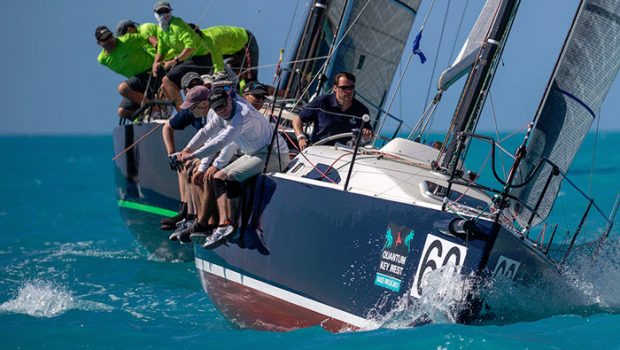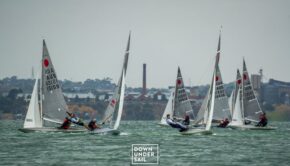How Racing Rating Rules Work
Published on May 30th, 2018
Quantum Sail Designer Chris Williams is an expert when it comes to getting the most out of your racing rating (such as IRC, ORCi, and ORR). Here, he helps you understand how ratings work and how to make sure you don’t miss the podium because of your rating.
Rating rules are a powerful tool that allow a variety of yachts to compete on a level playing field. If you race a tortoise against a hare (assuming the hare is smart enough not to take a nap in the middle of the race), the hare will always win. Not really a fair match-up. The same goes for non-one design sailboat racing.
Being the first yacht over the finish, while impressive, doesn’t necessarily mean you sailed the best race comparatively. This is why rating rules come into play. It’s important to understand how they work so that you can work with your sailmaker and other specialists to optimize your program and level the playing field so your crew’s talent shines.
In the U.S., there are four main rating rules: Performance Handicap Racing Fleet (PHRF), International Racing Conference (IRC), Offshore Racing Congress (ORCi), and Offshore Racing Rule (ORR). I will give a brief overview of how each rating rule assigns a rating, why it’s important to your program, and how Quantum can help make sure you have the best rating possible.
The Rating Rules
In general, rating systems assign a value to a yacht or a particular yacht set-up. This number is then used to correct finish times after each race. With all four rules, the most common way to score a race is using a time-on-time (TOT) or a time-on-distance (TOD) correction.
TOT corrections look at how long it takes to race; the TOD formula looks at the distance of the race. However, ORCi and ORR ratings take into account additional factors and have some flexibility for a custom correction formula.
PHRF is a simple handicap system, similar to what is used in golf. Considering the type of yacht, an assumed sail plan, and the team’s performance, a corrected-time handicap factor is assigned to the team. Races under PHRF rules correct times using TOD or TOT.
The other three rating rules get a bit more complicated. These rules use formulas to assign a rating to each yacht based on the yacht’s dimensions, construction, and design features. The formulas for IRC and ORR are closely guarded secrets; however, it is still possible for sailmakers, yacht builders, and other specialists to understand how various factors affect the rating. ORCi, on the other hand, has a published formula for designers to work with.
IRC looks at a number of yacht elements from sail size to weight and beam. It compares yachts as a percentage and then assigns the yacht a rating that corrects using TOT.
ORCi and ORR take things to the next level by using complex formulas to predict the speed of the yacht with a given set-up. These formulas are often referred to as Velocity Prediction Programs (VPP). There are a number of ways these ratings can be used to score a race. Some popular options are TOT, TOD, and performance curve scoring.
What Goes Into a Rating?
A large amount of data is plugged into IRC, ORCi, and ORR proprietary formulas that generate ratings for various conditions and situations. For example, an ORR certificate has multiple general ratings and also custom ratings for specific events such as the Chicago to Mackinac Race or Newport Bermuda Race.
Common data used to determine ratings includes hull data, sail measurements and types, crew and yacht weight, waterline, hardware, sailing trim, and other rigging data and measurements.
How Ratings Change
Due to a number of factors, your ratings can change even though your yacht hasn’t. The most common factor is sail size. Smaller sails equal a better rating across the board. And since all modern sails shrink with use, your ratings can change over time.
Every time you fold, hoist, or tack your sails, they shrink a bit from their original size. Similar to how a piece of paper shrinks each time you crumple it up and try to re-flatten it. Some sail constructions, such as those using a lot of Dyneema, tend to shrink more than carbon sails.
General yacht specifications from the yacht manufacturer are often used to compile data points; however, each yacht is unique, so having the correct data for your yacht and rig can go a long way toward improving your rating.
How to Optimize Your Rating
Because IRC, ORCi, and ORR ratings take into account a number of elements that affect the speed of the yacht, there is a lot of room to tweak your set-up to optimize your yacht for a particular racing rule. Sometimes a simple sail re-measurement is all it takes to better your handicap. That’s a game changer when you’re racing the 333-mile Chicago to Mackinac Race.
PHRF is harder to optimize due to the way ratings are assigned. Since the rating is based on the type of boat, it assumes these boats all use the same sail inventory. The best way to improve your PHRF rating is to improve your performance by using the sails your handicap is rated for.
We can help you review your rating and inventory and ensure the form is accurate. Our team is also able to explore how your regional PHRF committee measures the impact of switching from a pole and symmetrical spinnaker set-up to a fixed-pole asymmetrical set-up as that can also greatly affect your handicap.
Whether you have an existing rating or you need to apply for a new one, there are essentially three ways you can get the best, or at least a better, rating.
Option 1: Maximize what you’ve got.
This is the most common, easiest, and cheapest way to improve your rating. Bring your rating certificate and your largest sails to your local Quantum loft. We will start by verifying the sails listed on the certificate and re-measure them.
We’ll discuss your yacht and sail plan, your regatta schedule, and your overall program and where you want to take it. This gives us a better understanding and helps us identify other areas that can improve your rating and what to do next. Sometimes it’s as simple as helping you re-submit your form with the updated sail sizes.
Option 2: Deeper Analysis and Inventory
If your team is looking to take things to the next level or has a specific goal in mind, we can help guide you through the second option. It is a bit more expensive than the first option but definitely yields results.
After getting a handle on your current rating, goals, and budget, we’ll help coordinate and guide you through a whole-yacht optimization process using our in-house design team as well as other industry partners.
A sail designer like myself will look at your existing inventory and identify gaps or areas that could be improved or add new sails. We’ll run simulations to dial in your rating based on your sail plan and help you create a long-term sail plan.
The next step will be to work with other industry experts and review your yacht for potential changes or upgrades. They’ll be able to run multiple analyses of your set-up and identify areas that could benefit from re-evaluating your measurements, such as weighing your yacht to get an accurate weight instead of using the rules default values.
Option 3: Weather and Location Ratings
The third option builds on the first two options and optimizes your rating for specific wind conditions and/or specific locations. Working with other industry experts, we’ll get historical weather data for a particular event and run multiple simulations for the venue to further optimize your overall plan. This is a common practice with professional and Grand Prix teams.
There is a cost associated with this service, but it can highlight the best sails for a particular race and where to focus a team’s budget.
Regardless of where your program stands, we are here to help you understand how rating rules work and guide you to a better rating so that you and your team get the most out of the hard work you put in to cross the finish line. Email our team at optimizations@quantumsails.com to get the process started.









 We’ll keep your information safe.
We’ll keep your information safe.